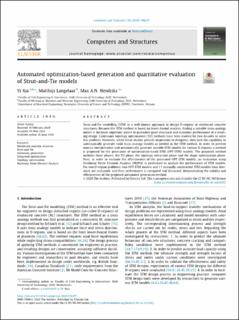| dc.contributor.author | Xia, Yi | |
| dc.contributor.author | Langelaar, Matthijs | |
| dc.contributor.author | Hendriks, Max | |
| dc.date.accessioned | 2021-04-08T08:47:01Z | |
| dc.date.available | 2021-04-08T08:47:01Z | |
| dc.date.created | 2021-01-19T15:45:25Z | |
| dc.date.issued | 2020 | |
| dc.identifier.citation | Computers & structures. 2020, 238 . | en_US |
| dc.identifier.issn | 0045-7949 | |
| dc.identifier.uri | https://hdl.handle.net/11250/2736778 | |
| dc.description.abstract | Strut-and-Tie modelling (STM) is a well-known approach to design D-regions in reinforced concrete structures. Because the STM method is based on lower-bound analysis, finding a suitable truss-analogy model is the most important aspect to guarantee good structural and economic performance of a resulting design. Continuum topology optimization (TO) methods have been studied for two decades to solve this problem. However, while these studies provide inspiration to designers, they lack the capability to automatically generate valid truss-analogy models as needed in the STM method. In order to prevent manual interpretation and automatically generate suitable STM models for various D-regions, a method is proposed for the generation of optimization-based STM (OPT-STM) models. The proposed method includes three phases: the TO phase, the topology extraction phase and the shape optimization phase. Next, in order to evaluate the effectiveness of the generated OPT-STM models, an evaluation using Nonlinear Finite Element Analysis (NLFEA) is performed to analyze the performance of STM models. For two D-region problems, two OPT-STM models and 11 manually constructed STM models from literature are evaluated, and their performance is compared and discussed, demonstrating the validity and effectiveness of the proposed automated generation method. | en_US |
| dc.language.iso | eng | en_US |
| dc.publisher | Elsevier | en_US |
| dc.rights | Attribution-NonCommercial-NoDerivatives 4.0 Internasjonal | * |
| dc.rights.uri | http://creativecommons.org/licenses/by-nc-nd/4.0/deed.no | * |
| dc.title | Automated optimization-based generation and quantitative evaluation of Strut-and-Tie models | en_US |
| dc.type | Peer reviewed | en_US |
| dc.type | Journal article | en_US |
| dc.description.version | publishedVersion | en_US |
| dc.source.pagenumber | 15 | en_US |
| dc.source.volume | 238 | en_US |
| dc.source.journal | Computers & structures | en_US |
| dc.identifier.doi | 10.1016/j.compstruc.2020.106297 | |
| dc.identifier.cristin | 1874603 | |
| cristin.ispublished | true | |
| cristin.fulltext | original | |
| cristin.qualitycode | 2 | |

